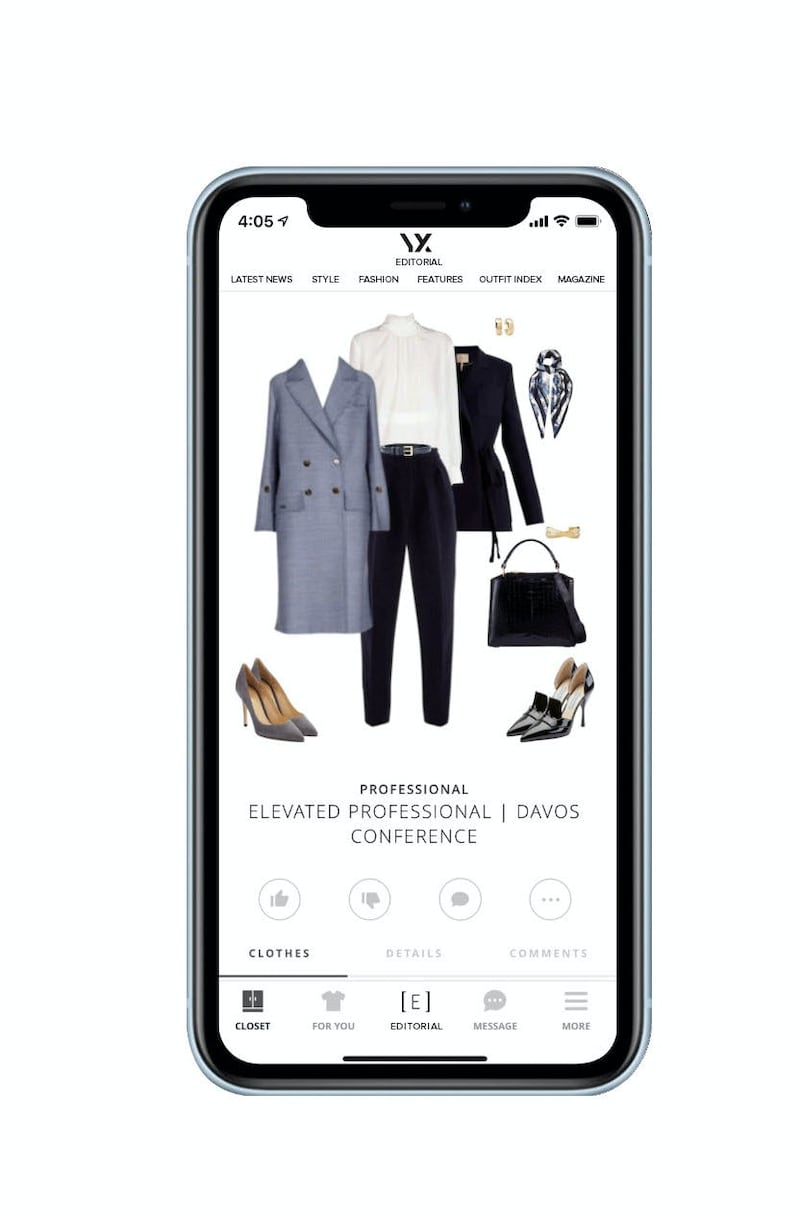
The Business of Fashion
Agenda-setting intelligence, analysis and advice for the global fashion community.

Agenda-setting intelligence, analysis and advice for the global fashion community.

NEW YORK, United States — There is a scene in the 1995 hit film Clueless that's stuff of fashion legend. Cher Horowitz, played by Alicia Silverstone, tells the camera she actually has "a way normal life for a teenage girl" because every morning after brushing her teeth, "I pick out my school clothes." Horowitz proceeds to boot up a virtual closet on her computer. She scrolls through outfit choices, with the program telling her what matches and what doesn't, before settling on a yellow plaid mini skirt and matching blazer.
Horowitz’s closet is etched into the minds of countless Millennials. It’s also something tech companies have tried to mimic almost since the film’s release nearly 25 years ago. The latest attempt is EditorialistYX, an app launching in September.
EditorialistYX will send a team to photograph items in users’ homes and upload them to a virtual closet. A quarterly fee on top of a subscription cost also includes access to personal stylists, and the company will receive a commission if a customer buys a product based on their recommendation.

An outfit put together in EditorialistYX's digital closet app | Courtesy
ADVERTISEMENT
The app is a product of Editorialist, a fashion e-commerce site and online magazine, and Project YX, a start-up specialising in artificial intelligence wardrobe management software that acquired the Editorialist earlier this summer. Project YX has raised $8 million from investors, including music producer Scooter Braun.
EditorialistYX is hardly the first company to deliver an alleged "closet of the future." Apps like Cladwell, GlamOutfit, ShopLook and ClosetSpace make similar promises. EditorialistYX's biggest competitor would likely be Finery, a company that builds a digital closet by tracking online purchases, and has raised $5 million from investors like New Enterprise Associates. Stylitics, an AI company that recommends outfits to shoppers on e-commerce sites like Gap, Ann Taylor, Macy's and Calvin Klein just raised $15 million in a Series B funding found.
All of these apps are betting that personalisation is the future of e-commerce. Online retailers have tracked user activity since the early days of the internet, and are growing more sophisticated about how they use that information to offer a unique shopping experience to each customer. A BoF/McKinsey survey of fashion executives last year found that personalisation is the biggest trend driving fashion businesses. Over 70 percent of US consumers expect some kind of personalisation element from online shopping destinations, according to a Linkdex survey.
At its simplest, personalisation can mean showing different ads or displaying an alternative version of a brand’s website based on a consumer’s search history. Some companies are building their entire business model around the concept, whether it’s Stitch Fix’s personalised style recommendations or Rent the Runway’s stream of clothing suggestions.
Hyper-personalised online shopping experiences, experts say, is the best way to achieve high rates of customer acquisition.
“Personalisation is the key for e-commerce today because it makes customers feel like they are getting a tailored shopping experience,” said Krista Corrigan, a fashion tech analyst at Edited. “It’s what keeps them coming back.”
Personalisation is the key for e-commerce today because it makes customers feel like they are getting a tailored shopping experience.
Even so, virtual closets have yet to catch on. They require a fair amount of work by users to set up, whether it’s uploading images of clothes or compiling a list of past purchases.
EditorialistYX hopes to overcome that by offering to handle the setup.
ADVERTISEMENT
“Digital closets have been abject failures,” said Rafael Ortiz, co-founder of Project YX. “The fatal flaw was the onboarding service, which has always been too laborious. The reality is, very few people want to photograph their closet themselves, and so our approach is to make the experience completely seamless for the client.”
The service’s luxury price point also stands out from other styling services. A membership that includes onboarding an entire closet costs $6,000, with a quarterly fee of $500 to unlock virtual styling and lists of outfits. A $3,000 membership covers onboarding for 150 items.
This is a customer segment that is willing to spend — the company’s internal research found clients using a beta version of its app spent $65,000 a year on luxury goods and had a closet of 412 items. Luxury brands have also been slow to embrace personalisation online, with some still avoiding e-commerce entirely.
The new luxury is having a personalised, intimate shopping experience where someone is delivering a one-on-one touch point.
EditorialistYX plans to capture some of that spending by using data generated from the virtual closets to inform stylists’ recommendations. This is a key part of Stitch Fix’s success; using feedback from previous orders to better tailor future recommendations. EditorialistYX will focus on luxury shopper, though, a customer segment that Stitch Fix is not directly targeting.
“The new luxury is having a personalised, intimate shopping experience where someone is delivering a one-on-one touchpoint,” said Kate Davidson Hudson, Editorialist’s co-founder. “A lot of luxury purchases are already happening at traditional retail stores, where shoppers chat one-on-one with store associates because they’ve built a connection with them. We’re tapping into that in an efficient way.”
Related Articles:
[ Why Brands Are Sliding Into Your DMsOpens in new window ]
[ Finery Aims to Succeed Where Other Virtual Closets Have NotOpens in new window ]
[ Can a Festival Help Zalando Build a Memorable Brand?Opens in new window ]
BoF Careers provides essential sector insights for fashion's technology and e-commerce professionals this month, to help you decode fashion’s commercial and creative landscape.
The algorithms TikTok relies on for its operations are deemed core to ByteDance overall operations, which would make a sale of the app with algorithms highly unlikely.
The app, owned by TikTok parent company ByteDance, has been promising to help emerging US labels get started selling in China at the same time that TikTok stares down a ban by the US for its ties to China.
Zero10 offers digital solutions through AR mirrors, leveraged in-store and in window displays, to brands like Tommy Hilfiger and Coach. Co-founder and CEO George Yashin discusses the latest advancements in AR and how fashion companies can leverage the technology to boost consumer experiences via retail touchpoints and brand experiences.